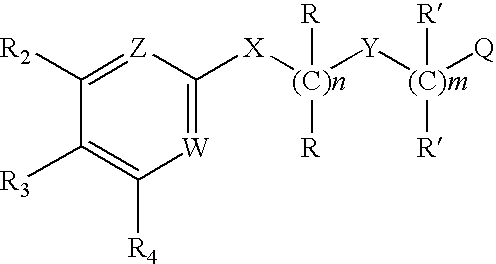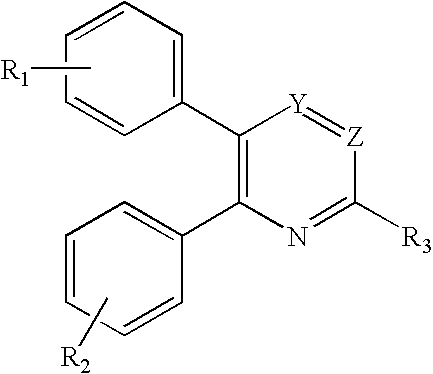Substituted 2,3-diphenyl pyridines
a technology of diphenyl pyridine and substituted pyridine, which is applied in the direction of drug compositions, inorganic non-active ingredients, metabolic disorders, etc., can solve the problems of psychosis, overeating, hypothermia, memory loss,
- Summary
- Abstract
- Description
- Claims
- Application Information
AI Technical Summary
Problems solved by technology
Method used
Image
Examples
example 1
[0983]
Methyl 2-(benzyloxy)-6-(4-chlorophenyl)-5-(phenyl)pyridine-3-carboxylate
[0984] Step A: 3-Dimethylamino-1-(4-chlorophenyl)-2-(phenyl)prop-2-en-1-one
[0985] A solution of benzyl 4-chlorophenyl ketone (10.0 g, 43.3 mmol) and dimethylformamide dimethylacetal (23 mL, 173 mmol) in DMF (125 mL) was heated at 75° C. for 20 h. The volatiles were removed in vacuo to provide 3-dimethylamino-1-(4-chlorophenyl)-2-(phenyl)prop-2-en-1-one (43.3 mmol assumed) which was used directly in the next step. 1HNMR (CDCl3): δ2.76 (s, 6H), 7.15 (m, 2H), 7.16-7.3 (m, 5H), 7.36 (m, 2H), 7.41 (s, 1H).
[0986] Step B: 6-(4-Chlorophenyl)-5-(phenyl)-2-oxo-1,2-dihydropyridine-3-nitrile
[0987] A solution of 3-dimethylamino-1-(4-chlorophenyl)-2-(phenyl)prop-2-en-1-one (43.3 mmol assumed) from Step A, cyanoacetamide (4.0 g, 47.6 mmol), and methanol (3.9 mL, 95 mmol) in DMF (100 mL) was added dropwise to a suspension of sodium hydride (60% in mineral oil) (4.3 g, 108 mmol) in DMF (50 mL) at rt. After the slow add...
example 2
[0996]
Methyl 2-(allyloxy)-6-(4-chlorophenyl)-5-(phenyl)pyridine-3-carboxylate
[0997] Using essentially the same procedure as in Example 1, Step E, but substituting allyl bromide for benzyl bromide, methyl 6-(4-chlorophenyl)-5-(phenyl)-2-oxo-1,2-dihydropyridine-3-carboxylate (500 mg, 1.47 mmol) from Example 1, Step D afforded the desired higher Rf O-alkylation title compound after purification by flash column chromatography on silica gel (eluted with a gradient of 5 to 10% ethyl acetate in hexanes). HPLC / MS: 380 (M+1); Rt=4.7 min. 1HNMR (CDCl3): δ3.954 (s, 3H), 5.09 (br d, J=5 Hz, 2H), 5.32 (dd, J=1.5 and 10.5 Hz, 1H), 5.45 (br dd, J=1.6 and 18 Hz, 1H), 6.13-6.23 (m, 1H), 7.16-7.21 (m, 2H), 7.22 (d, J=8.6 Hz, 2H), 7.30-7.36 (m, 3H), 7.37 (d, J=8.6 Hz, 2H), 8.246 (s, 1H).
example 3
[0998]
2-(Benzyloxy)-6-(4-chlorophenyl)-5-(phenyl)pyridine-3-nitrile
[0999] To a solution of 6-(4-chlorophenyl)-5-(phenyl)-2-oxo-1,2-dihydropyridine-3-nitrile (200 mg, 0.65 mmol) from Example 1, Step B in DMF (3 mL) was added benzyl bromide (0.10 mL, 0.85 mmol) and then cesium carbonate (276 mg, 0.85 mmol). The reaction was stirred at 55° C. for 3 h and was then diluted with water and extracted twice with methylene chloride. The organic layers were washed with a portion of brine and the combined organic layers were dried over anhydrous sodium sulfate and concentrated in vacuo. The products were separated by preparative TLC (30% ethyl acetate in hexanes) to give the desired higher Rf O-alkylation title product. HPLC / MS: 397 (M+1); Rt=4.8 min. 1HNMR (CDCl3): δ5.614 (s, 2H), 7.13 (m,2H), 7.24 (br d, J=8.6 Hz, 2H), 7.27-7.40 (m, 6H), 7.43 (br t, J=7.6 Hz, 2H), 7.54 (br d, J=7.2 Hz, 2H), 7.922 (s, 1H). The lower Rf band gave the N-alkylation by-product, methyl 1-benzyl-6-(4-chlorophenyl)-...
PUM
| Property | Measurement | Unit |
|---|---|---|
| Mass | aaaaa | aaaaa |
| Electric charge | aaaaa | aaaaa |
| Electric charge | aaaaa | aaaaa |
Abstract
Description
Claims
Application Information
 Login to View More
Login to View More - R&D
- Intellectual Property
- Life Sciences
- Materials
- Tech Scout
- Unparalleled Data Quality
- Higher Quality Content
- 60% Fewer Hallucinations
Browse by: Latest US Patents, China's latest patents, Technical Efficacy Thesaurus, Application Domain, Technology Topic, Popular Technical Reports.
© 2025 PatSnap. All rights reserved.Legal|Privacy policy|Modern Slavery Act Transparency Statement|Sitemap|About US| Contact US: help@patsnap.com



